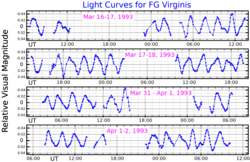FG Virginis
Appearance
| Observation data J2000.0
| |
|---|---|
| Constellation | Virgo |
| Right ascension | 12h 14m 15.457s[2] |
| Declination | −05° 42′ 59.75″[2] |
| Apparent magnitude (V) | 6.56[3] (6.53 to 6.58)[4] |
| Characteristics | |
| Evolutionary stage | Main sequence |
| Spectral type | A8/9V[5] |
| U−B color index | 0.05[6] |
| B−V color index | 0.277±0.007[3] |
| Variable type | δ Sct[4] |
| Absolute magnitude (MV) | 2.10[3] |
| Details | |
Rotational velocity (v sin i) | 21.3±1.0[11] km/s |
| Database references | |
| SIMBAD | data |
FG Virginis is a well-studied
lunar occultations.[13]
The variability of this star was first reported by
pulsating stars in the instability strip.[14] It was subsequently grouped in the class of Delta Scuti variables, which show a pulsation period of less than a day.[15] Observations in 1984 by P. Lopez de Coca showed at least one pulsation period with a cycle of 1.9 hours.[16] L. Mantegazza and associates in 1994 were able to detect seven or more pulsation modes, with the previously detected dominant mode being a radial pulsation with a frequency of 12.72 cycles per day.[17]
The star became of interest to
astroseismology study because of its relatively slow rotation rate and the numerous modes of pulsation. A multi-site campaign involving the Whole Earth Telescope network was conducted in 1993 to observe this star, which detected ten modes.[1] This was increased to 24 frequencies in 1998,[18] then 67 independent frequencies with 79 total by 2005. Evidence suggests there are many more such modes.[19]
This is an
projected rotational velocity of 21 km/s, but the actual rotational velocity is likely much higher at around 80 km/s.[11]
References
- ^ Bibcode:1995A&A...297..473B.
- ^ .
- ^ S2CID 119257644.
- ^ S2CID 125853869.
- ^ Bibcode:1999MSS...C05....0H.
- ^ hdl:10261/226673.
- ^ .
- S2CID 18429588.
- doi:10.1553/cia144s5.
- ^ S2CID 54036626.
- ^ Bibcode:2019JAD....25....1B.
- ^ "FG Vir", SIMBAD, Centre de données astronomiques de Strasbourg, retrieved 2022-06-14.
- doi:10.1086/190595. See event no. 528.
- S2CID 120025134.
- Bibcode:1973A&A....23..221B.
- Bibcode:1984IBVS.2465....1L.
- Bibcode:1994A&A...287...95M.
- Bibcode:1999A&A...341..151B.
- S2CID 119042031.
- S2CID 123022971.
Further reading
- Haas, P. (2011), "Analyses of Crawford's uvby β calibrations using the pulsational variations of FG Vir", Communications in Asteroseismology, 162: 3, doi:10.1553/cia162s3.
- Lenz, P.; et al. (April 2008), "Determination of intrinsic mode amplitudes of the δ Scuti stars FG Vir and 44 Tau", Communications in Asteroseismology, 153: 40–48, .
- Daszyńska-Daszkiewicz, J.; et al. (August 2005), "Inferences from pulsational amplitudes and phases for multimode δ Sct star FG Vir", Astronomy & Astrophysics, 438 (2): 653–660, S2CID 119384957.
- Kirbiyik, H.; et al. (February 2005), "A new oscillating model suggestion for FG Vir", Astrophysics and Space Science, 295 (4 7): 473–484, S2CID 121788461.
- Breger, M.; et al. (May 2004), "The δ Scuti star FG Vir. V. The 2002 photometric multisite campaign", Astronomy & Astrophysics, 419 (2): 695–701, S2CID 119519055.
- Mantegazza, L.; Poretti, E. (December 2002), "Line profile variations in the delta Scuti star FG Virginis: A high number of axisymmetric modes", Astronomy & Astrophysics, 396 (3): 911–916, S2CID 118962688.
- Templeton, Matthew; et al. (December 2001), "Asteroseismology of δ Scuti Stars: A Parameter Study and Application to Seismology of FG Virginis", The Astrophysical Journal, 563 (2): 999–1012, S2CID 119387461.
- Zima, W. (July 2001), "The Spectroscopic and Photometric DSN Campaign 2002 of FG Vir", Communications in Asteroseismology, 140: 57–58, Bibcode:2001CoAst.140...57Z.
- Dziembowski, W. A.; et al. (November 1998), Kjeldsen, H.; Bedding, T. R. (eds.), "Oscillations in XX Pyx and FG VIR and the prospects for asteroseismology of delta Scuti stars from space", The First MONS Workshop: Science with a Small Space Telescope, held in Aarhus, Denmark, June 29–30, 1998, Aarhus Universitet, p. 127, Bibcode:1998mons.proc..127D.
- Viskum, M.; et al. (July 1998), "Oscillation mode identifications and models for the delta Scuti star FG Virginis", Astronomy & Astrophysics, 335: 549–560, Bibcode:1998A&A...335..549V.
- Breger, M.; et al. (March 1998), "The delta Scuti star FG Vir. III. The 1995 multisite campaign and the detection of 24 pulsation frequencies", Astronomy & Astrophysics, 331: 271–279, Bibcode:1998A&A...331..271B.
- Stankov, A.; Zima, W. (March 1998), "Photometry of the Delta Scuti Star FG VIR during the 1995 Multi-Site Campaign", Baltic Astronomy, 7 (2): 243–253, S2CID 117560195.
- Breger, M.; et al. (May 1996), "The δ Scuti star FG Virginis. II. A search for high pulsation frequencies", Astronomy & Astrophysics, 309: 197–202, Bibcode:1996A&A...309..197B.
- Guzik, J. A.; Bradley, P. A. (September 1995), "Models and mode identifications of the Delta Scuti Star FG Vir", Delta Scuti Star Newsletter, 9 (9): 7–14, Bibcode:1995DSSN....9....7G.
- Breger, M. (September 1995), "The 1995 FG VIR campaign: will 550 hours of new data and 19 frequencies be enough to do asteroseismology?", Delta Scuti Star Newsletter, 9 (9): 14–17, Bibcode:1995DSSN....9...14B.
- Dawson, D. W.; et al. (June 1995), "A Photometric Study of the delta Scuti Star FG Virginis Undertaken during 1985/6", Publications of the Astronomical Society of the Pacific, 107: 517–520, S2CID 123547347.
- Dawson, D. W. (March 1990), "The Period Structure of FG Virginis", Bulletin of the American Astronomical Society, 22: 831, Bibcode:1990BAAS...22..831D.
- Gonzalez-Bedolla, S. F.; Rodriguez, E. (February 1990), "FG Vir, Additional Photoelectric Observations", Information Bulletin on Variable Stars, 3426: 1, Bibcode:1990IBVS.3426....1G.

